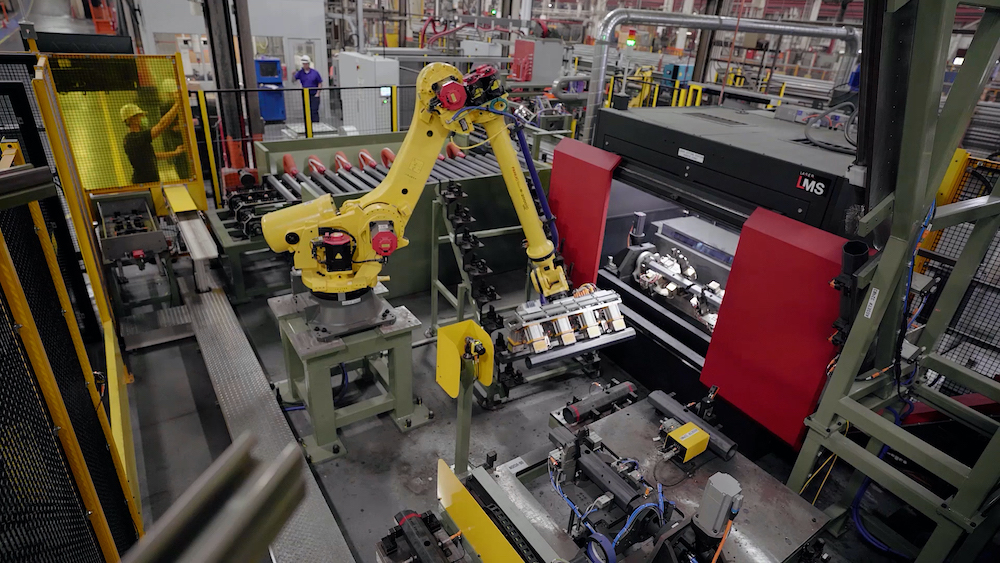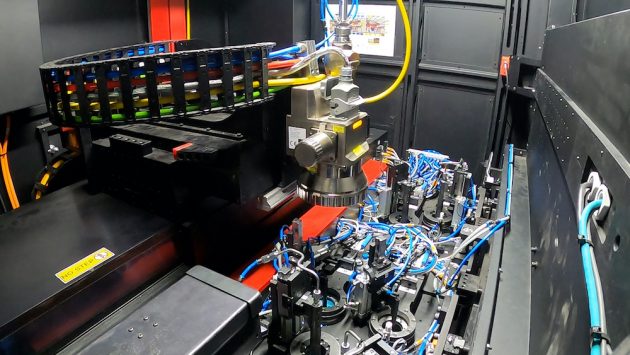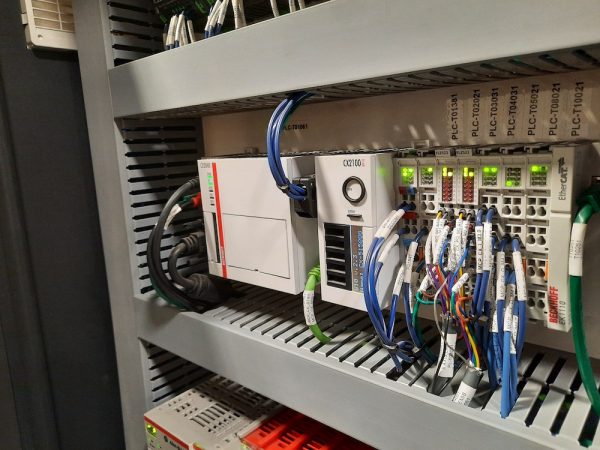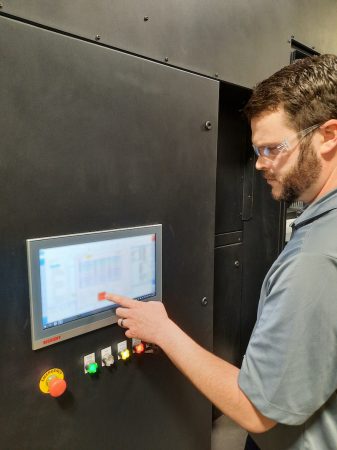
Connected control: BOS Innovations links laser-cutting with robotics
June 24, 2021
By James Figy
Flexible EtherCAT and PC-based automation help a dual OEM-system integrator create an adaptable laser cutting solution for a Tier 1 automotive manufacturer

The best of both worlds – that’s what BOS Innovations strives to provide a broad base of manufacturing customers.
As both a machine builder OEM and system integrator, the Dorchester, Ont. company combines its strength in delivering turnkey machines with the ability to retrofit and tie into existing factory lines and systems, primarily in automotive and heavy industries.
“We have developed core competencies in automated assembly, advanced robotics including welding, laser processing, coordinated motion technology, collaborative robots and quality inspection,” says Ben Huigenbos, president of BOS.
These complementary capabilities were clear in a recent implementation of the company’s L-MS (Laser-Motion System) for a Tier 1 automotive manufacturer. The L-MS is an advanced fibre laser cutting machine, equipped with a direct drive linear motion system for precision CNC control.
This high-performance machine produces complex parts with tight tolerances by leveraging up to five axes of coordinated motion. While L-MS supports drop-in installation, this project also required peripheral systems to meet all of the customer’s needs, according to Steve Van Loon, technology manager, lasers and motion systems at BOS.
“To make this L-MS a truly turnkey system, we needed to add a robot to load and unload the parts and move them to stations for de-burring, vision inspection and marking with an instant marker,” Van Loon says. “Most other laser machine providers do not do that. They are more geared toward manual-load production and simply provide the laser machine and a basic automation interface.”
BOS goes a step further and delivers turnkey cutting fixtures with all necessary referencing to make high-quality parts, whether in a manual loading system or the Tier 1 automotive customer’s completely automated setup.

BOS can customize the L-MS down to the tooling and changing out the laser cutting head in favour of a welding head, for example. Photo: BOS Innovations
Flexible, modular controls
To make sure the L-MS could support a best-of-both-worlds approach for many customers, the BOS engineering team made flexibility and modularity top priorities in the initial design. In addition to a standard 1 kW fibre laser, the cutting head can accommodate up to two 0.5-6 kW laser sources or even welding or remote welding.
Providing this high degree of flexibility required robust yet adaptable controls and networking technologies that would allow the L-MS to integrate with other systems in the plant.
The machine has options for fume extraction equipment, automated scrap conveying, automatic doors and safety scanners for operator or robotic loading. The parts can sit on a flat bed or use a trunnion system with additional servo axes to rotate the workpiece 360 degrees. By adding a turntable, the loading time can occur in parallel with the laser process.
The flexibility even extends to footprint: The L-MS cell, a roughly two-metre cube designed for 1,300-mm-long parts, can be expanded on all sides to accommodate workpieces of many sizes.
Providing this high degree of flexibility required robust yet adaptable controls and networking technologies that would allow the L-MS to integrate with other systems in the plant. Highly synchronized motor and drive technologies for the cutting axes were critical to ensure part quality. So was openness to enable real-time communication to the robot controller, de-burr components and vision system.
To address this, Van Loon worked with mechanical designers Riley Tomiuck and Scott McCall on the design. The team determined that the system required higher performance than a traditional fieldbus and hardware PLC could deliver, so they turned to solutions from Beckhoff Automation.
BOS first implemented Beckhoff technologies a decade ago on a large cardboard converting system that had about 50 motion axes, and other projects followed. Then in 2018, BOS used Beckhoff to build the first iteration of the L-MS, which was designed to cut SUV running boards, and decided to tweak the machine to be a standard offering in its portfolio.
For this project, the team worked closely with the local Beckhoff team – Automation Sales Engineer Dean Herron and Application Engineer Rui Zhang – to design, program and commission the automation system.

A CX2040 Embedded PC from Beckhoff delivers processing power to operate the high-speed, coordinated motion system. Photo: BOS Innovations
Motion technologies with EtherCAT
BOS implemented precision motion control on the L-MS using a variety of rotary servo motor and direct drive solutions with EtherCAT communication. The horizontal axes use Beckhoff AL2800 series Linear Motors, which deliver speeds up to 6 m/s and peak forces up to 4,500 N.
“The X and Y axes have highly dynamic requirements in terms of acceleration, speed and accuracy, which called for linear motors,” Van Loon says. The client’s machine featured a Z axis and a trunnion system, which both used AM8000 servo motors.
AX5000 servo drives with One Cable Technology (OCT) provided motion control and reductions in motor cabling, and they permitted easy integration of a smaller, third-party motor to control the theta axis on the cutting head.
The machine processes octagonal steel tube parts of variable wall thicknesses, cuts a 21.5-degree angle on one end of each piece and handles two variants with either six or 12 holes while maintaining tight tolerances.
EtherCAT provided real-time communication for the L-MS system, and a wide variety of Beckhoff I/O components offered the necessary functionality.
As an inherently open industrial Ethernet system that supports communication to more than 30 protocols, EtherCAT made it easy to connect to other components on the production line.
“EtherCAT uses distributed clocks in each device to deliver tight synchronization and jitter of less than 1 µs, which is optimal for coordinated motion systems like the L-MS,” Herron explains. “With a theoretical cap of over 65,000 devices on a single network, free choice of topology and no required switches, EtherCAT has practically no limitations, whether in a system with five axes or 50.”
As an inherently open industrial Ethernet system that supports communication to more than 30 protocols, EtherCAT made it easy to connect to other components on the production line via a simple EtherNet/IP bus coupler.
In addition to EtherCAT couplers and I/O terminals from Beckhoff, BOS also implemented TwinSAFE functional safety modules. TwinSAFE technology relies on Safety over EtherCAT (FSoE), a TÜV-certified communication technology that uses a “black channel” approach to transmit safety data over the standard network.
This allows engineers to place safety terminals in standard I/O segments, according to Zhang: “BOS used the EL6900 TwinSAFE logic terminal as a safety PLC on this machine.
This approach allowed them to cut down the time and complexity otherwise required for hardwiring safety switches. All I/Os stay on the same rack or mount onto the machine with IP67 box modules, and they could simply create safety logic in the standard TwinCAT engineering environment.”

The L-MS machine features a CP2916 control panel from Beckhoff for an industrial-hardened operator interface. Photo: BOS Innovations
Control software and hardware
With TwinCAT 3 automation software, BOS equipped the client’s engineers to select the programming languages they are most familiar with or that best suit the project, including the object-oriented extensions of IEC 61131-3, computer science standards in Microsoft Visual Studio and predefined or custom function blocks.
Control of the L-MS relies on a single Beckhoff CX2040 embedded PC. The DIN-rail-mounted CX2040 features a quad-core Intel Core i7 processor, 80 GB CFast flash card and 4 GB DDR3 RAM. A 15.6-inch CP2916 control panel provides multi-touch operator interface and high-resolution display for camera results from the laser-cutting machine.
Delivering the best of both worlds
The complete L-MS system went live in the end user’s facility in late 2020. With fast controls and automated loading, the machine achieves a part-to-part cycle time of 40 seconds or less.
“The L-MS easily runs at two metres per second with 1.25 G acceleration, and it cuts holes with the highest precision that the customer has ever seen,” Van Loon says. “That’s due to the controller speed and the fine tuning we accomplished with TwinCAT Scope.
Using the digital oscilloscope, we could see all parameters on the screen and collect data from each axis, including following error, acceleration, deceleration and more, to optimize the system.”
EtherCAT provided benefits in terms of bandwidth and speed, along with footprint and cost reductions. “Coordinated motion requires a lot of data to be passed between the servo drives and motion planner. EtherCAT is really the only fieldbus capable of handling that,” Van Loon explains.
The finished L-MS met all requirements of the automotive customer, and BOS is building additional units for other customers. With the ability to customize the machine and build out the system in front of it, the BOS engineering team plans to keep innovating with its laser cutting machines and other systems to provide laser-focused solutions for customers.
_____
James Figy is a senior content specialist at Beckhoff Automation.
This article appears in the June 2021 issue of Manufacturing AUTOMATION.
Advertisement
- Survey: Border closures resulting in major losses, ‘immediate solution’ needed
- OTTO Motors robots now available globally